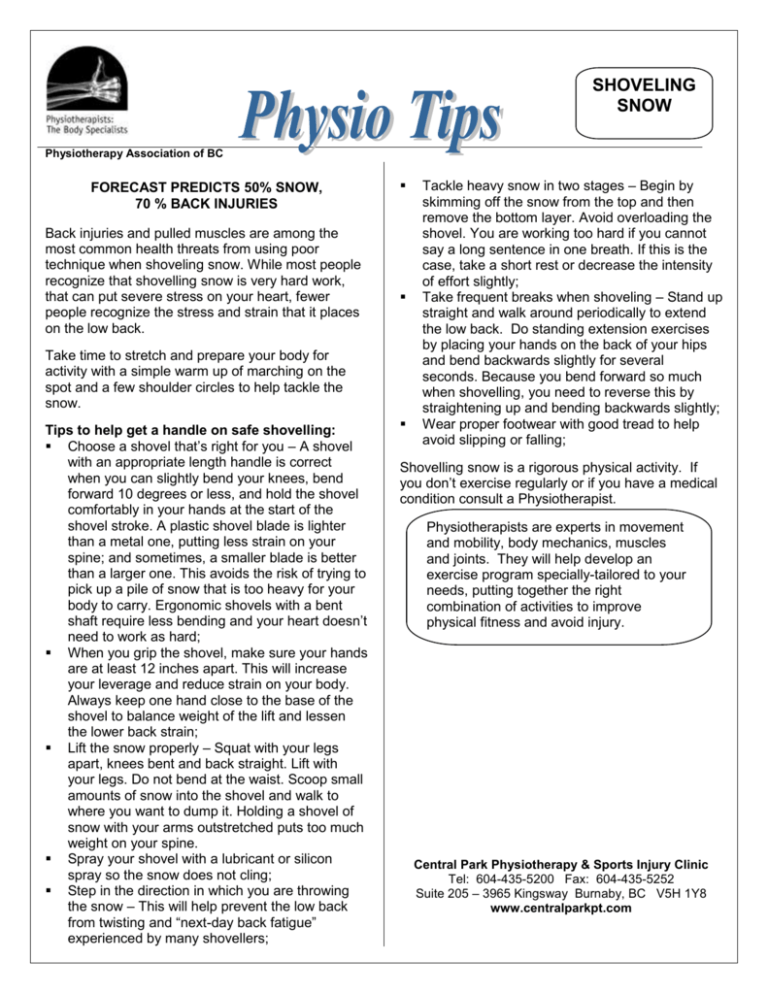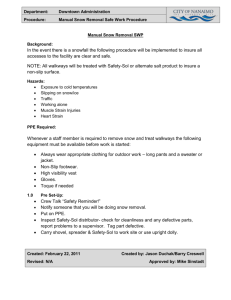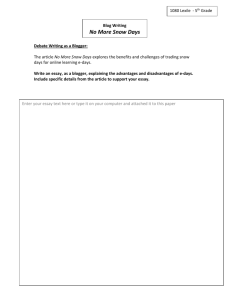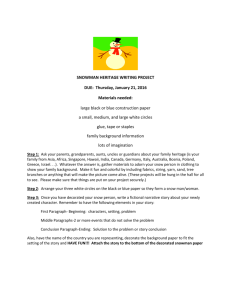FORECAST PREDICTS 50 PERCENT SNOW, 70 PERCENT BACK
advertisement

SHOVELING SNOW Physiotherapy Association of BC FORECAST PREDICTS 50% SNOW, 70 % BACK INJURIES Back injuries and pulled muscles are among the most common health threats from using poor technique when shoveling snow. While most people recognize that shovelling snow is very hard work, that can put severe stress on your heart, fewer people recognize the stress and strain that it places on the low back. Take time to stretch and prepare your body for activity with a simple warm up of marching on the spot and a few shoulder circles to help tackle the snow. Tips to help get a handle on safe shovelling: Choose a shovel that’s right for you – A shovel with an appropriate length handle is correct when you can slightly bend your knees, bend forward 10 degrees or less, and hold the shovel comfortably in your hands at the start of the shovel stroke. A plastic shovel blade is lighter than a metal one, putting less strain on your spine; and sometimes, a smaller blade is better than a larger one. This avoids the risk of trying to pick up a pile of snow that is too heavy for your body to carry. Ergonomic shovels with a bent shaft require less bending and your heart doesn’t need to work as hard; When you grip the shovel, make sure your hands are at least 12 inches apart. This will increase your leverage and reduce strain on your body. Always keep one hand close to the base of the shovel to balance weight of the lift and lessen the lower back strain; Lift the snow properly – Squat with your legs apart, knees bent and back straight. Lift with your legs. Do not bend at the waist. Scoop small amounts of snow into the shovel and walk to where you want to dump it. Holding a shovel of snow with your arms outstretched puts too much weight on your spine. Spray your shovel with a lubricant or silicon spray so the snow does not cling; Step in the direction in which you are throwing the snow – This will help prevent the low back from twisting and “next-day back fatigue” experienced by many shovellers; Tackle heavy snow in two stages – Begin by skimming off the snow from the top and then remove the bottom layer. Avoid overloading the shovel. You are working too hard if you cannot say a long sentence in one breath. If this is the case, take a short rest or decrease the intensity of effort slightly; Take frequent breaks when shoveling – Stand up straight and walk around periodically to extend the low back. Do standing extension exercises by placing your hands on the back of your hips and bend backwards slightly for several seconds. Because you bend forward so much when shovelling, you need to reverse this by straightening up and bending backwards slightly; Wear proper footwear with good tread to help avoid slipping or falling; Shovelling snow is a rigorous physical activity. If you don’t exercise regularly or if you have a medical condition consult a Physiotherapist. Physiotherapists are experts in movement and mobility, body mechanics, muscles and joints. They will help develop an exercise program specially-tailored to your needs, putting together the right combination of activities to improve physical fitness and avoid injury. Central Park Physiotherapy & Sports Injury Clinic Tel: 604-435-5200 Fax: 604-435-5252 Suite 205 – 3965 Kingsway Burnaby, BC V5H 1Y8 www.centralparkpt.com







